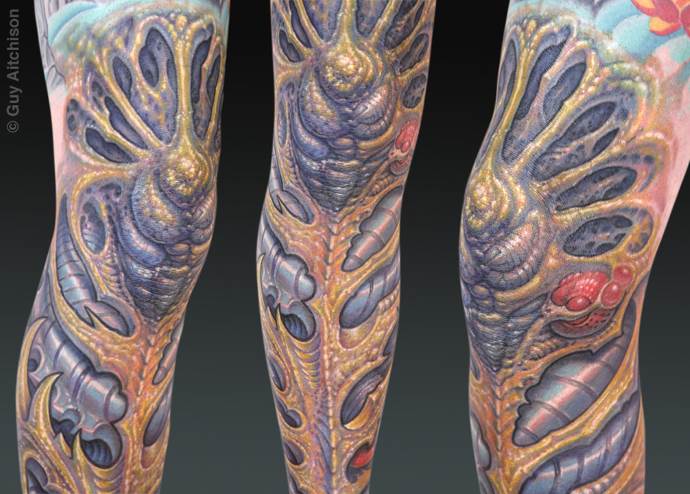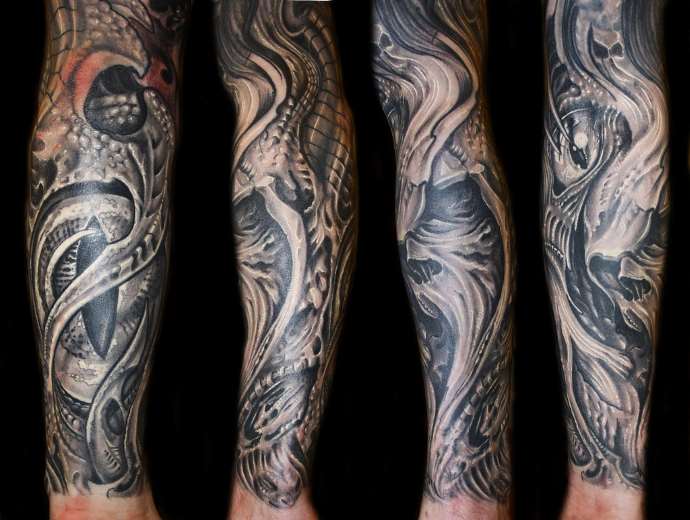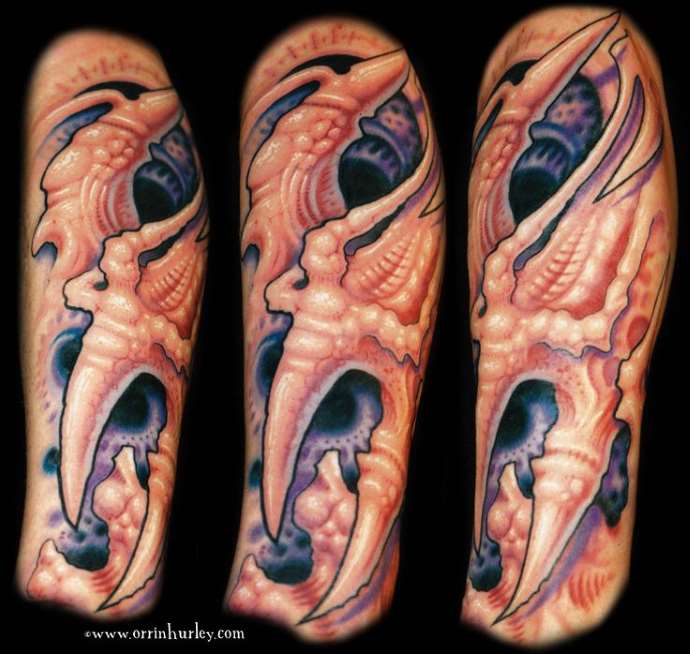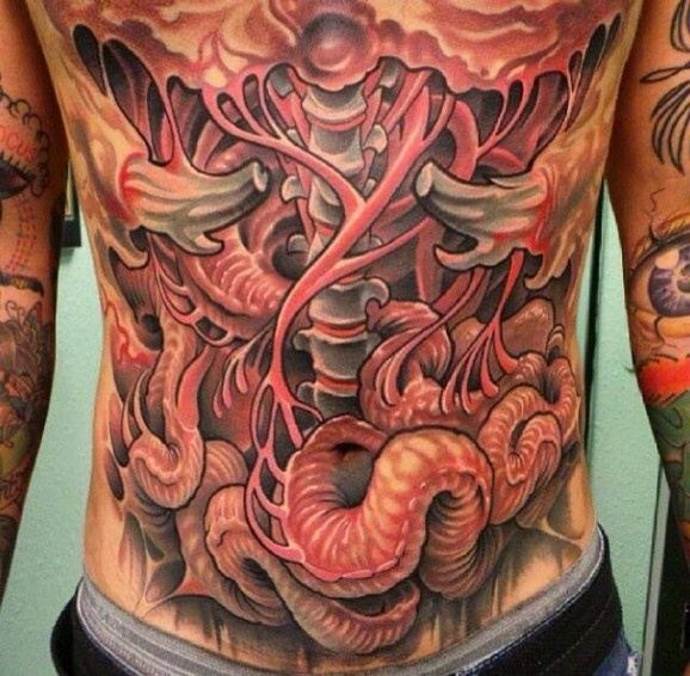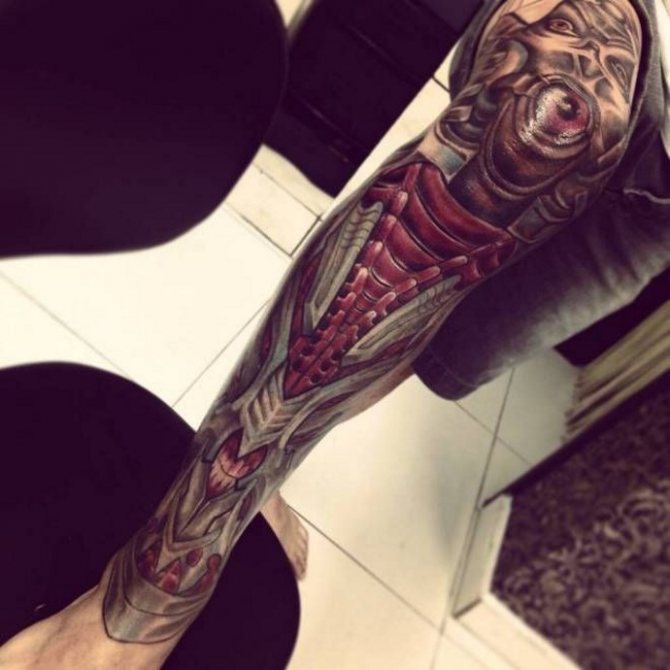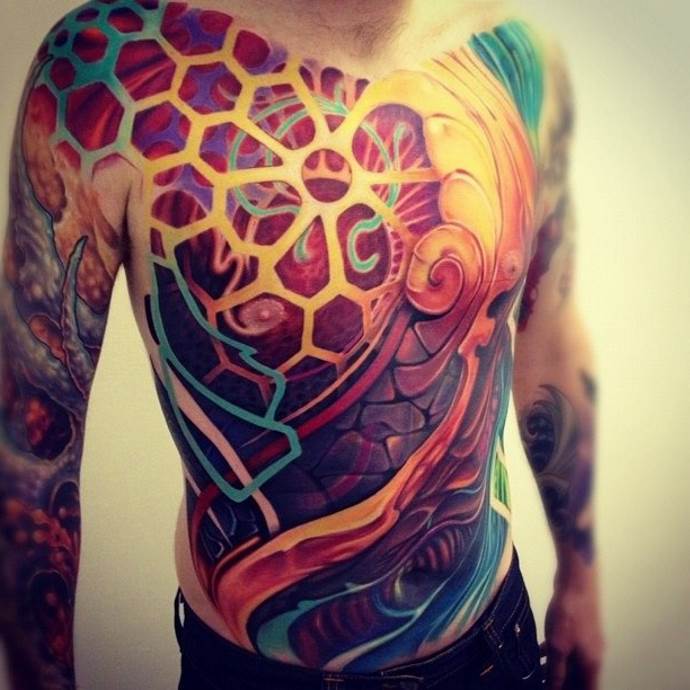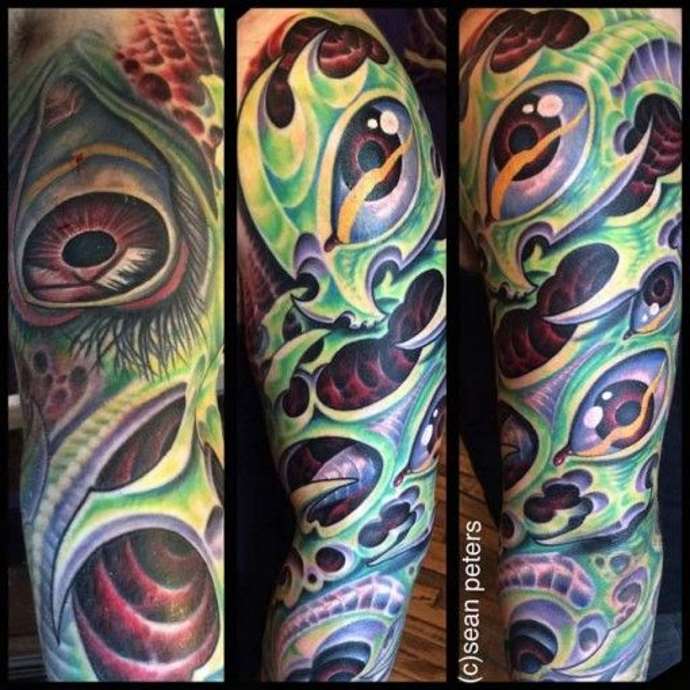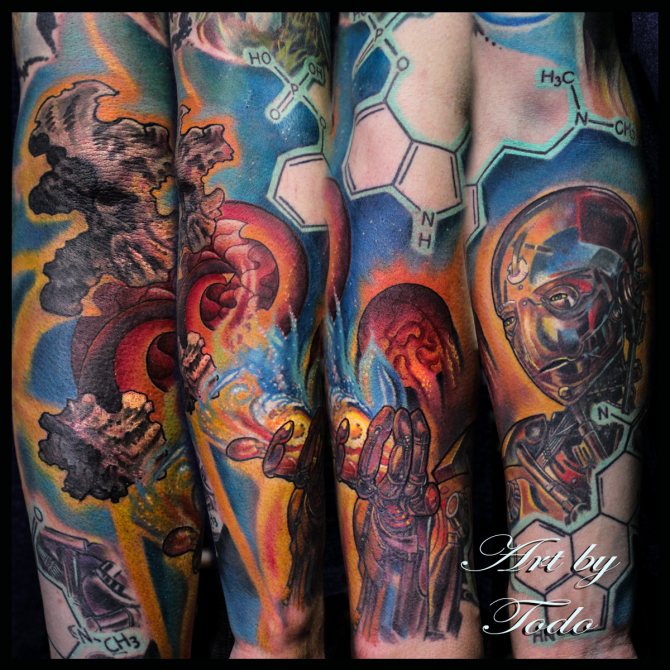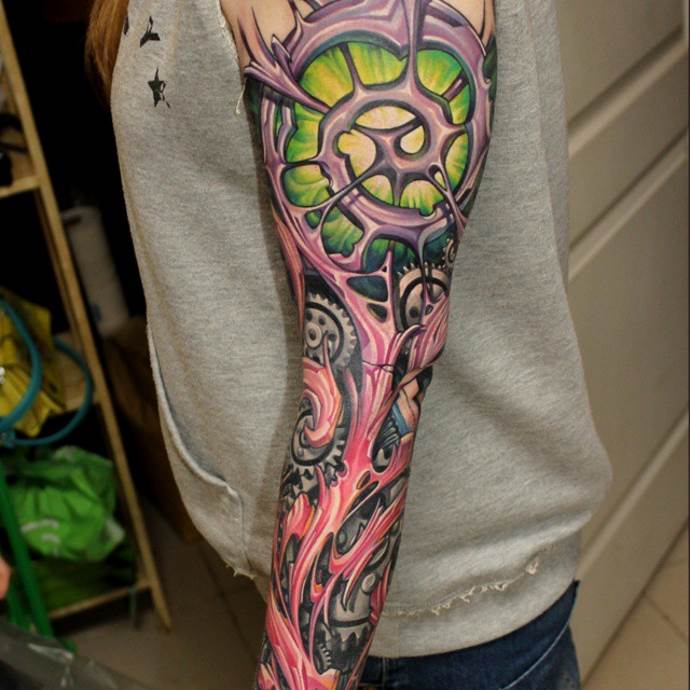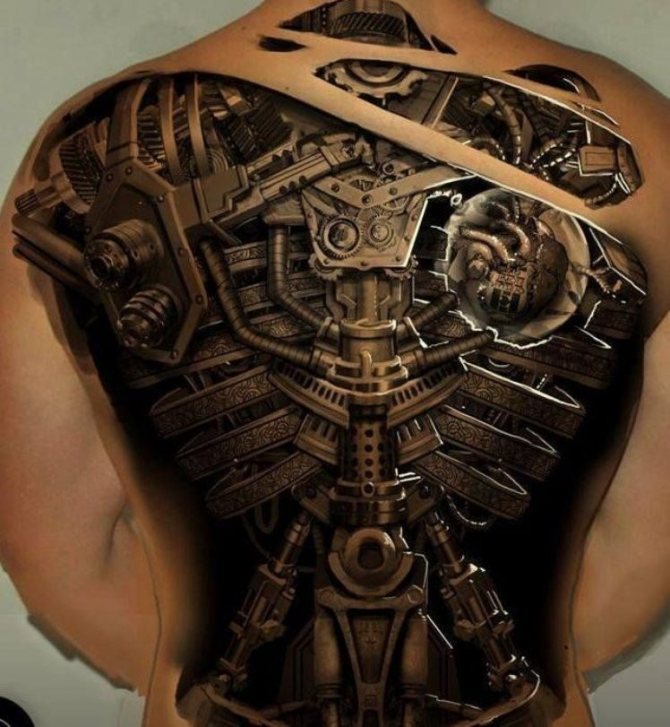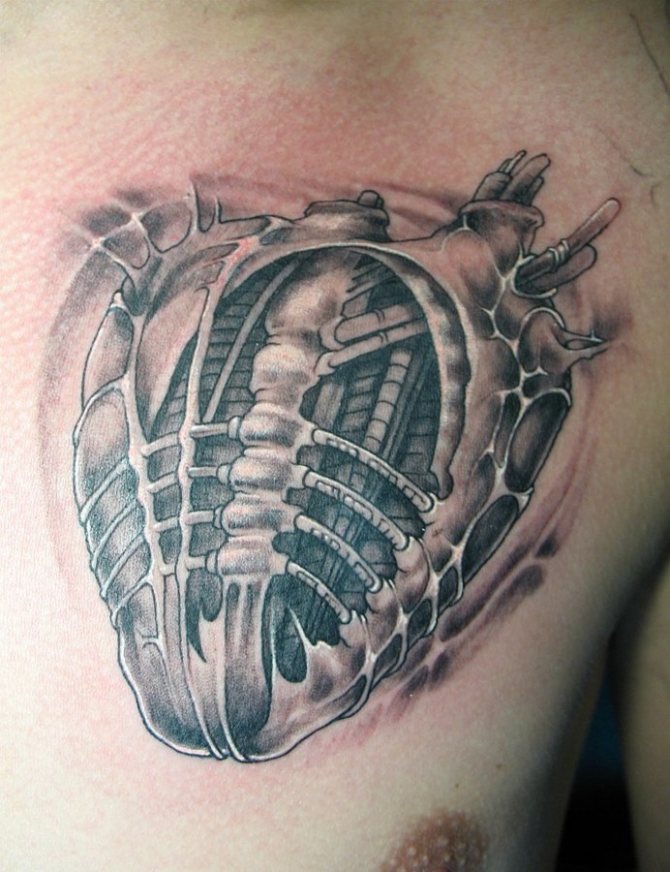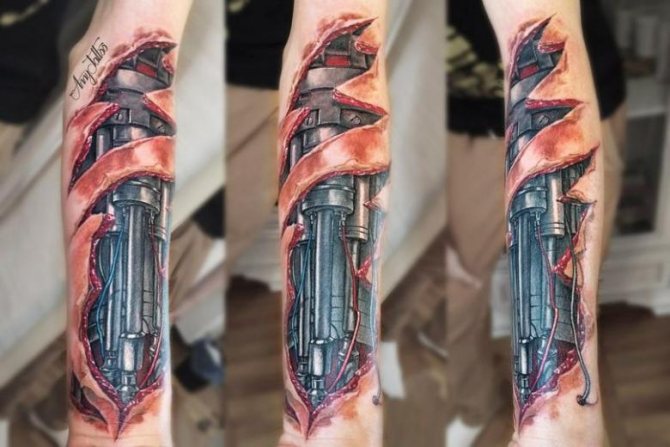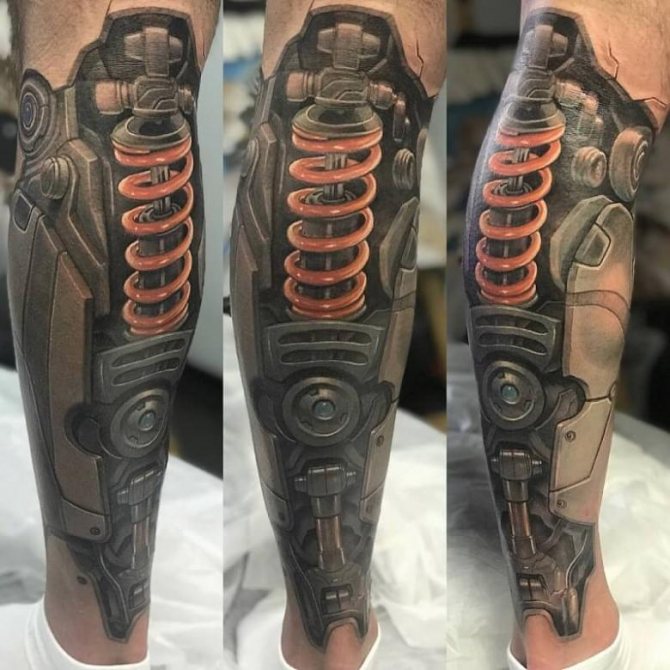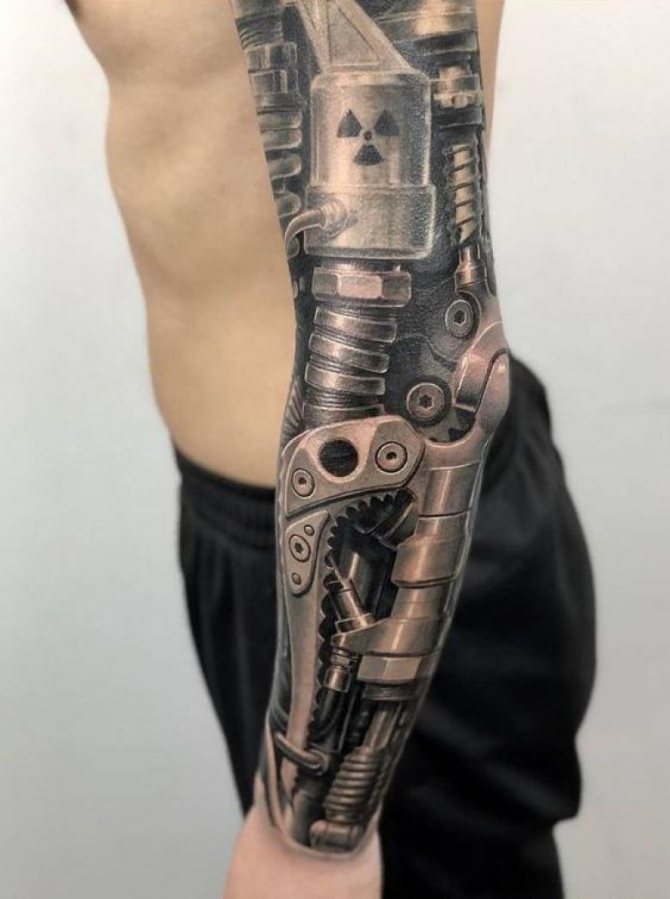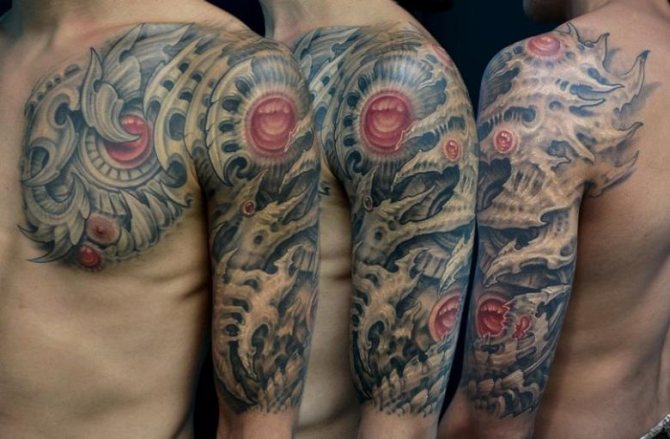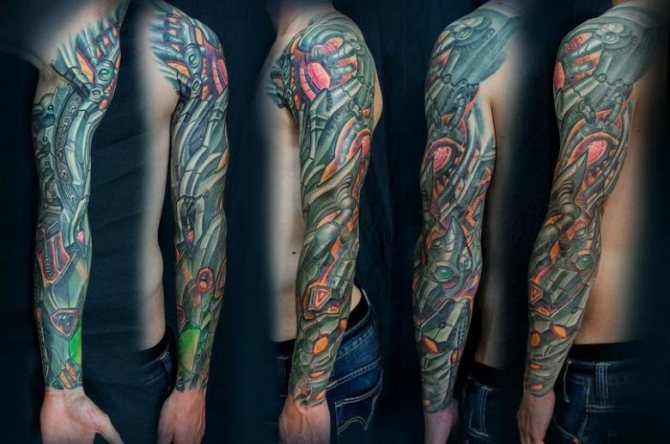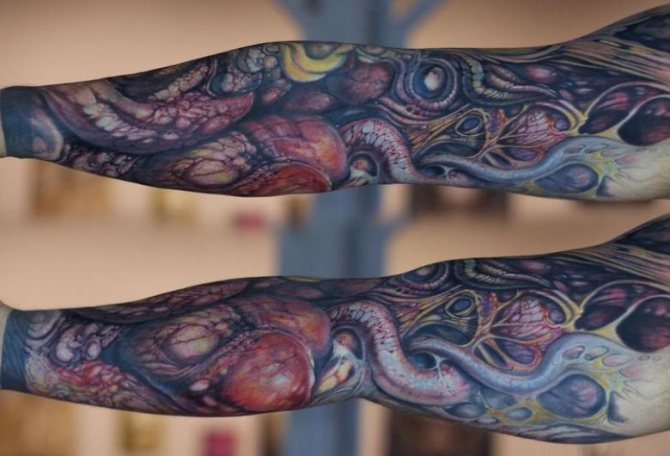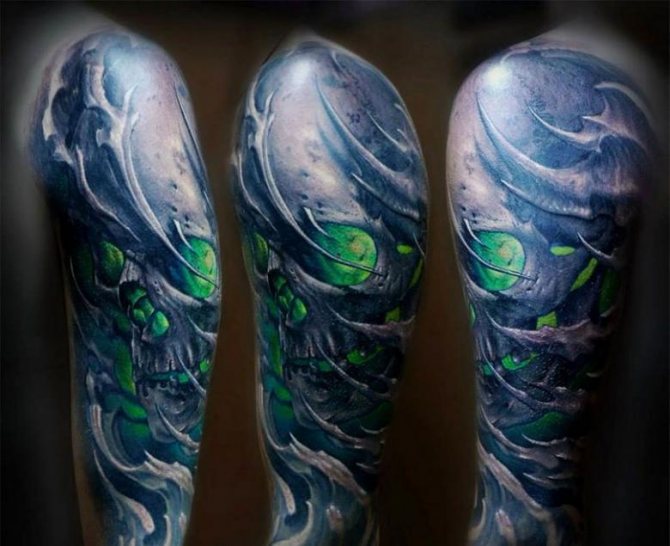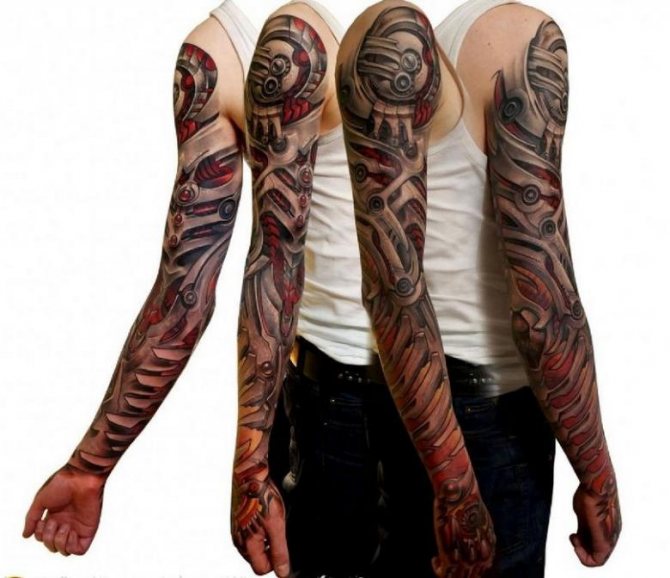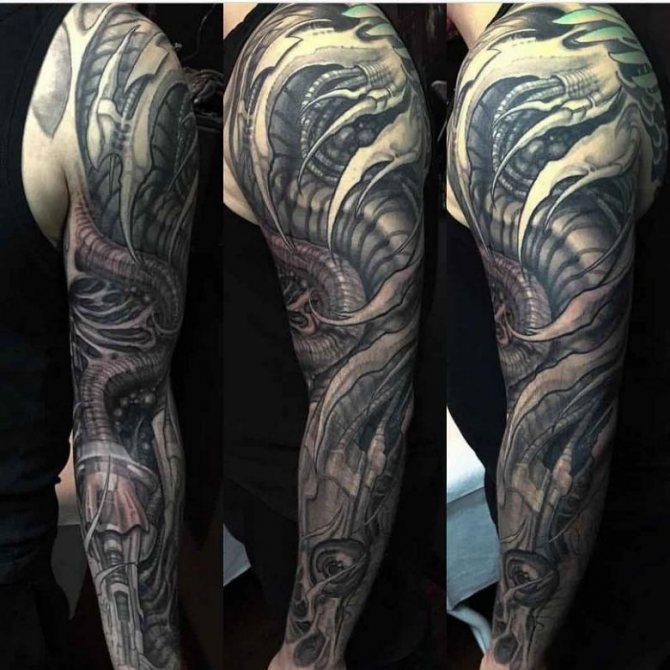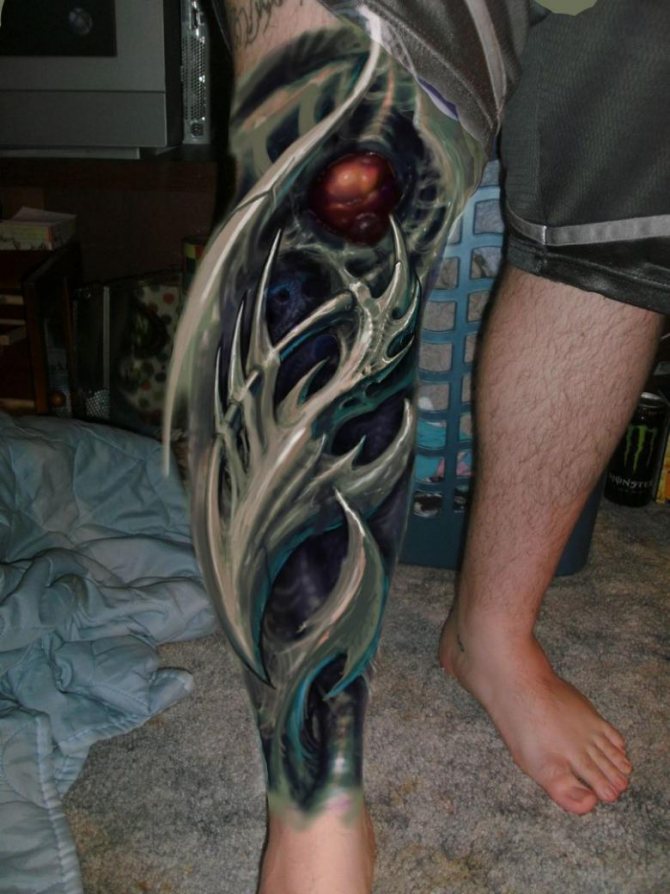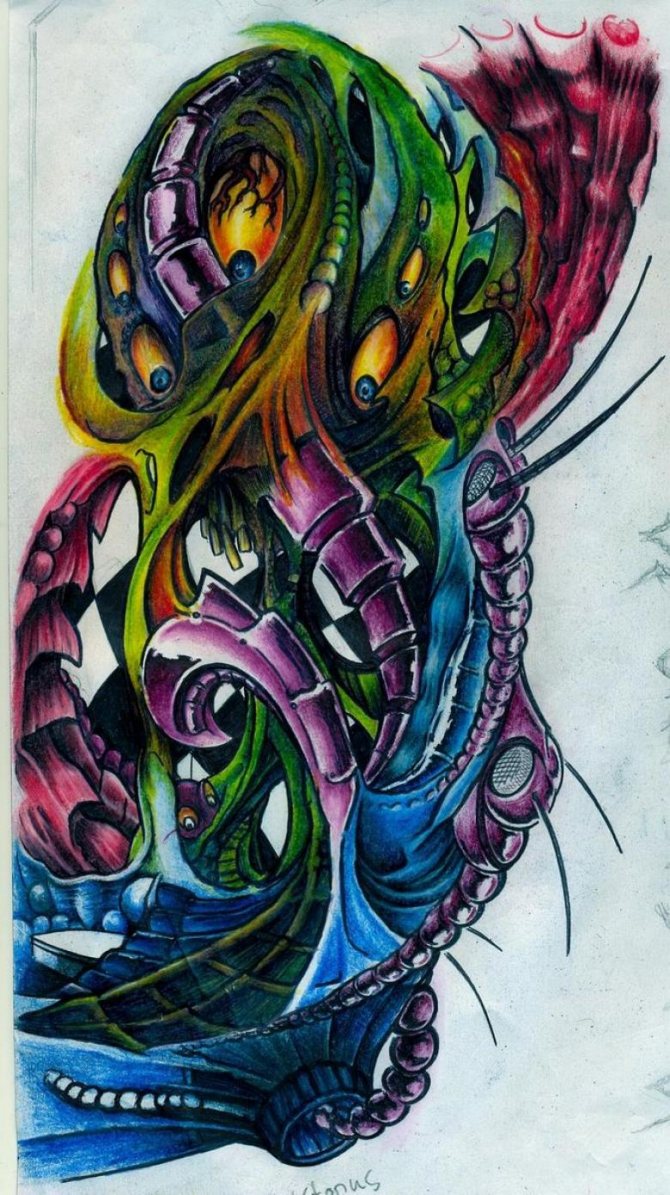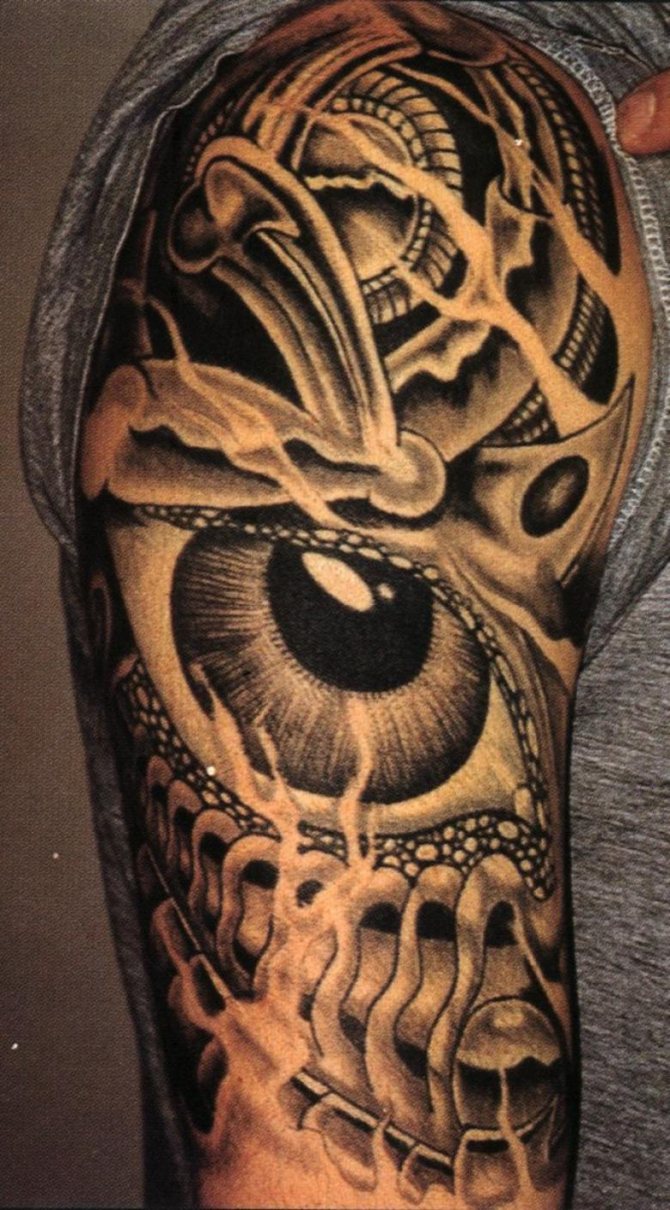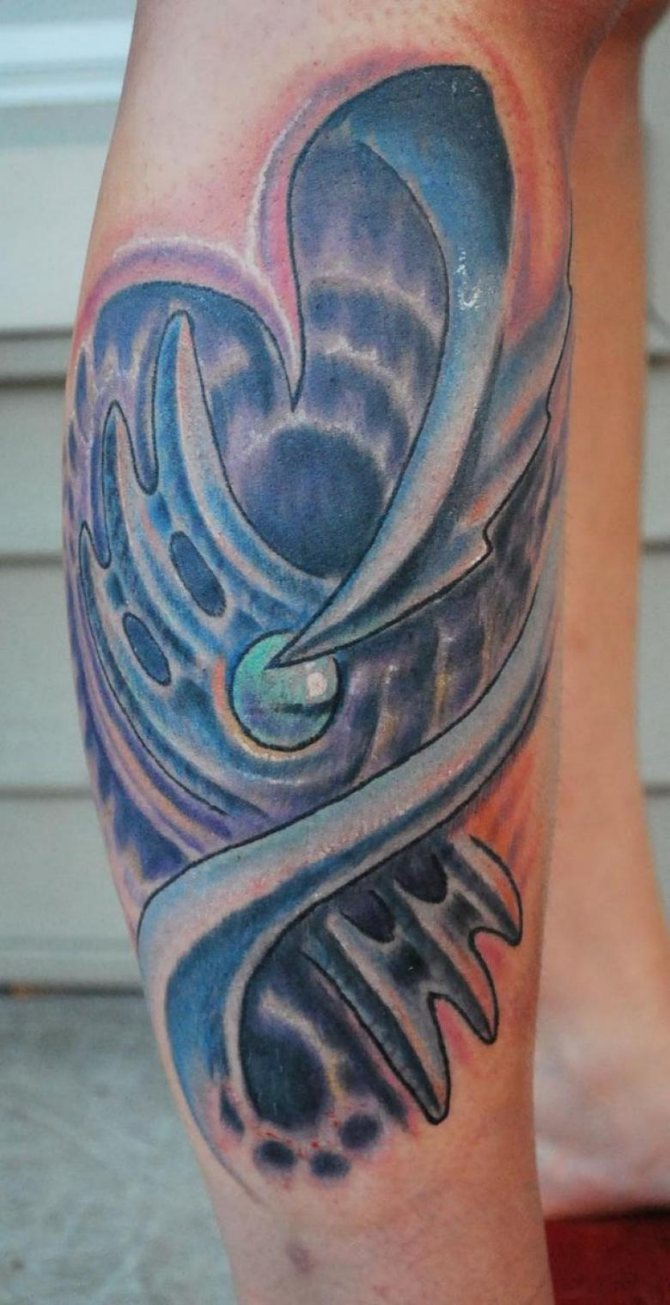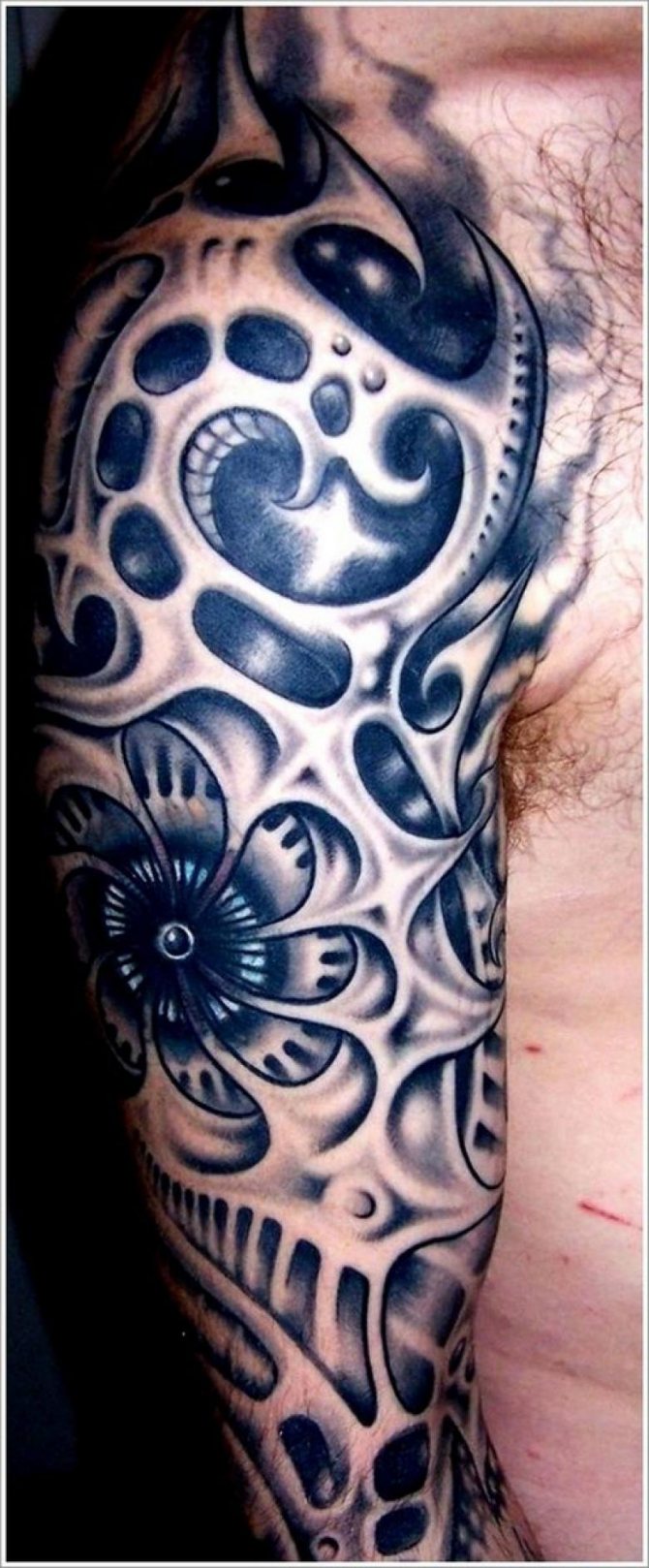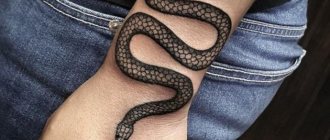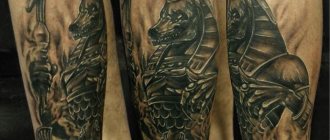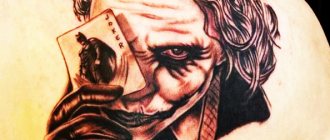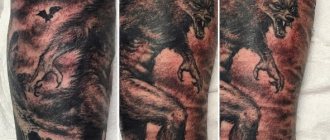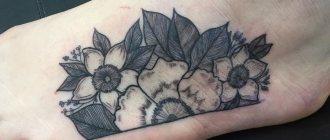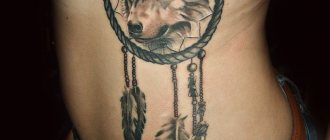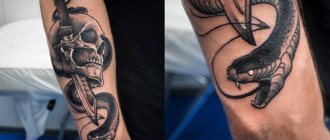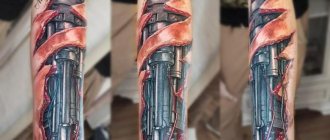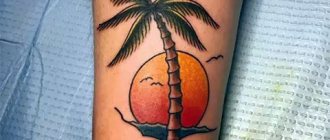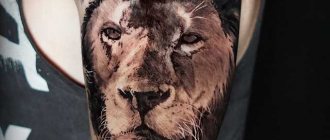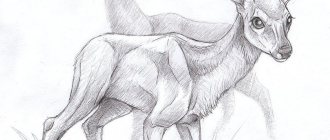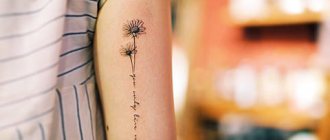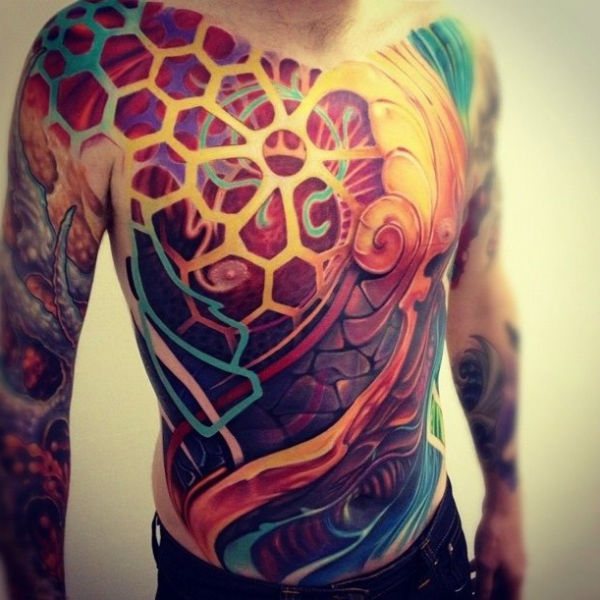
Organic tattoo is a creative type of tattoo, closely connected with biomechanics, but instead of mechanical elements it contains abstract elements close to nature, animals and various drawings. This type of art began its development in the last quarter of the twentieth century, immediately after the style of biomechanics.
This style is unique in that it has no limit to the artist's imagination and is characterized by a bright palette of colors. It is from the union between organic and natural design that we see the real art in the field of tattooing.
Features of the style
Organic style tattoos are bright and positive. This perception is influenced by the color palette used by the masters. The brightest shades of colors, up to acidic, are allowed here. Among tattoo styles this is one of those that does not prohibit and even encourages bold experiments with colorism.
Performed in this style rhythmic abstract compositions harmoniously and smoothly merge with the skin. They often have a light or neutral message. The basis of the direction are the elements close to the natural. They are drawn on the skin with soft and smoothed lines.
For natal drawings are characterized by careful tracing. The works use detailing, shadowing. They are characterized by shades and contrasts. The color scheme used is often acidic, but you can also find examples of tattoos in warm tones.
History
The organics trend emerged in the 1980s at the same time as the biomechanics style. Its founder is considered to be the tattoo artist Guy Atchison from America. In the course of his work, he prefers to first implement the ideas in the sculpture, and then to apply the drawing. While biomechanics embodies the bleakness and hopelessness of life, organics is filled with positivity and bright colors.
The style is rapidly developing in tattoo culture, but due to the complexity of creating compositions there are not so many outstanding tattoo artists working in this direction in the world. Roman Abrego, Nick Baxter are the most popular and talented artists of our time, creating in this genre.
Subjects
The Organic style is characterized by all kinds of forms, essentially filled with biofactures. Creating a sketch, the master can be inspired by macro-photos of representatives of the natural world. These can be enlarged images of seeds, stones, fruits. The basis of the organic style are harmonious elements, natural or having a similarity with them.
Organics is often compared to biomechanics. The techniques of these two styles are similar, but they are very different in subject matter. Organics refers to the natural, plant world, whereas the subject of interest in biomechanics is a mechanical reality. In contrast to the living vegetation there are various motors, cables, hoses, chips.
Organics is one of the few styles of tattooing where a spectacular "torn skin" technique is possible. This is one of the spectacular visual effects, as if allowing you to look inside the body through the "formed" hole. And there could be some metallic details or, as in the case of organics, natural elements.
Organics is inherently abstract, so there is no specific set of subjects in this case. In the sketches, you can see bones, minerals, dead shellfish. Among the less typical drawings, created more at the intersection of styles, are images of living creatures. This can be a snake against a background of algae or a profile of a nymph girl emerging from a plant background. Sometimes the authors "weave" into the organic traditional tattoo subject - skulls.
The main meanings of the tattoo
One of the characteristic features of the bioorganic style in the absence of a serious or important meaning. The task of the plot is in the spectacular demonstration of the features and structure of the skin, the internal structure of the body. That's why a huge advantage of the direction is the possibility of realizing your own fantasies with personal meaning.
Among the most common elements of tattoos can be attributed as living creatures (snakes, fish, butterflies, birds), and parts of the internal structure of the human body (bones, organs, blood vessels).
| Theme | Description and meaning of the fragment |
| The heart surrounded by veins and arteries | The task of naturalistic details tell about the love of life of the bearer of the tattoo. He is a fan of naturalness, his body is analogous to a natural system of organs braided with vessels. |
| Plants and seeds sprouting from the flesh | If in traditional sketches the inclusion of plant motifs looks like an external detail, bio-organics "drives" flowers and stems into the skin, creating a unity with it. |
| Insects, snakes, turtles | The image of organics crawling or flying out of the body is a hint at the dark side of the world. This is a signal to others - the owner of the tattoo does not deny mysticism in life. |
Interestingly, the elements of the outer covering fragments of plants (bark) and animals (shell, scales) are used in the picture to replace the skin. Often the image of an eye - faceted or regular, but of large size - is hammered into the cover.
Creative tattoos are closely related to biomechanics, but the mechanical elements are replaced by abstract details of natural and plant type. The main difference of bio-organics is the brightness and contrast of color used to accentuate the individuality of the wearer.
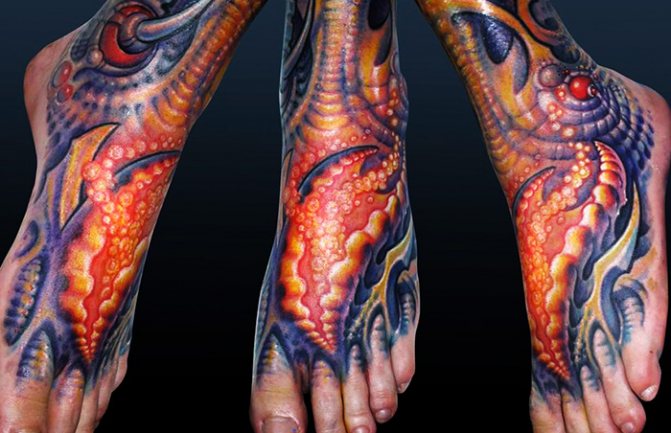

Monochromes are rare, because they are blamed for the gloomy aggressiveness of bio-mechanics. Bioorganic style pleases the eye with a riot of colors, absence of straight lines and strict geometry, which is so characteristic of nature.
Similar styles
"Neighbor" of the organic style is the already mentioned above biomechanics. Also, the technique of torn skin is used by steampunk. This style involves the creation of drawings with vapor mechanisms, as if placed in the human body. Among all three directions, it is the organics that are the softest, the smoothest. Therefore if the reception of torn skin in a tattoo will interest not the client, but the client, most likely, the master will recommend to it to familiarize with sketches Organic. Many believe that the style is best suited for women. A drawing created within the framework of this direction can look quite gentle. However, there are also neutral in mood, and even enough masculine sketches.
According to the technique of applying the organic tattoo is one of the most difficult. Before the master is the problem to transfer the sketch to the skin, harmoniously blended it on the human body. To transfer all the halftones of the image, maximum meticulousness is required. So a large organic tattoo you will do not one session.
The origin of the stylistics
Surrealism of Bioorganics is entirely decorative, continuing the stylistics of tattoos of the main direction, which is Biomechanics. However, Bioorganics differs from the ancestral style in the absence of mechanical parts, wires and metal. When working on the sketches tattoo artists are inspired by macro pictures of nature and the human body.


The author of bio-organics is considered to be the American tattooist Guy Atchison.who first implemented his fantastical ideas in sculptural compositions. After carefully considering the arrangement of light sources and the selection of textures, the artist painted pictures according to the subject he had conceived.
This is how Atchison became the "father" of biomechanics, and on its basis an organic trend was formed that did not aim to reliably depict "replacing" the internal "components" of the body with mechanics.
According to another version, the style of bio-organic tattoo appeared in America at the end of the last century, and the source of inspiration for the creation of unusual sketches were pictures of Swiss artist Hans Giger. His work is an intertwining of fiction and reality.
The master became world famous after the embodiment on the canvas of the image of "Alien", the hero of the cult epic with the same name. Giger's fantastic realism turned into biomechanics, on the basis of which the color-positive bio-organics emerged.
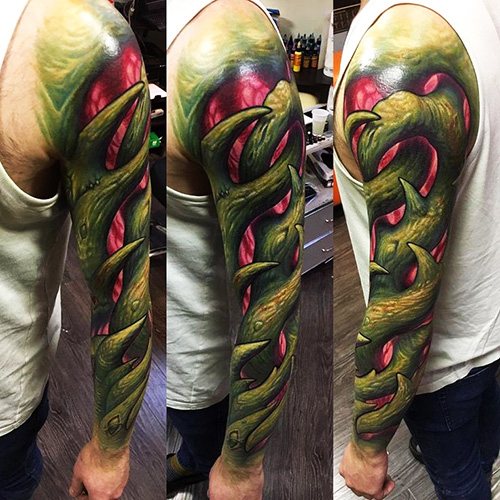

Further, ethereal images from modern cinematography are smoothly transferred to the subjects of body painting, surprising others with the cool design of tattooed paintings with elements of alien beings.
As a result, a colorful composition with a literate game of shadows, printed on a human arm or leg, transformed into a part of a limb of a being from another civilization or a character of a computer game.
Interestingly, highly skilled masters, perfectly mastering the technique of tattooing and having a good idea of the body anatomy, improve the motives of bio-tattoo directly on the client's body without making a paper sketch. The name of this progressive technique is "freehand".
Varieties of biomechanics
There are several types of tattoos of this style:
- Biomechanics proper. Mechanisms are depicted as an integral part of the person.
- Cyberpunk. Key features are buttons, plugs, and wires instead of vessels. The main difference from the previous type is the absence of torn flesh drawings. Examples include a cat with wires or an eye tattoo with gears.
- Hi-tech. Covers tattoos with images of microchips, chips and other elements of "smart technology" that are inherently organic.
There is another sub-style, which is akin to biomechanics. We are talking about Steam punk. It is characterized by drawings of obsolete mechanisms.
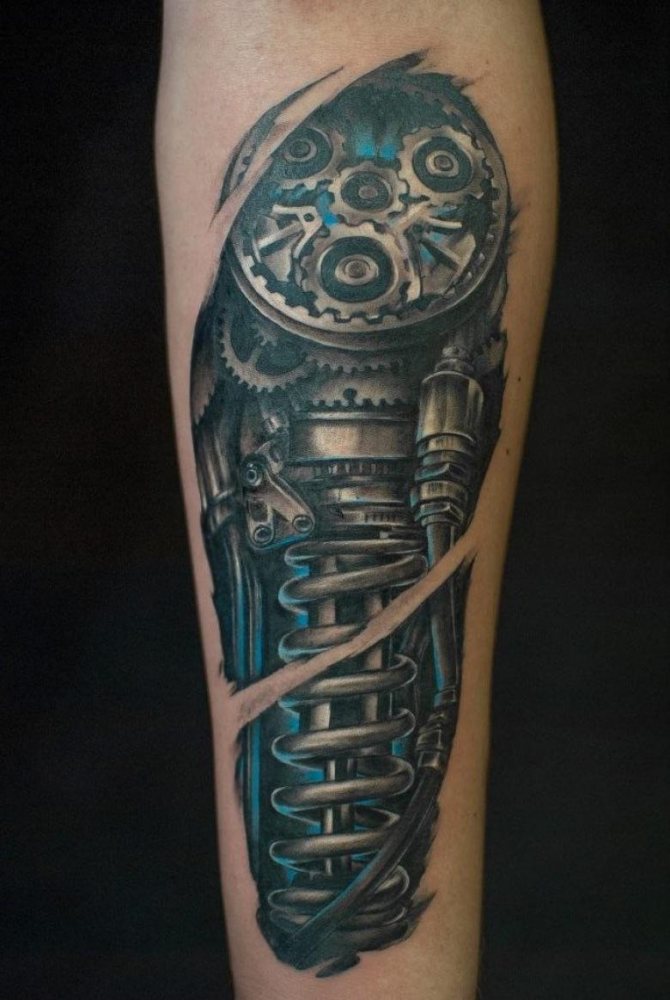

Features of the tattoo on the neck
It is necessary to carefully select a master, because the application of drawings on the neck is not safe. A person should not only be able to impose beautiful tattoos, but also understand the peculiarities of anatomy.
The importance of the location of the drawing
The placement of the tattoo can be placed in different ways:
- The collar, girdling the neck. More often such options are preferred by men. The sketches at the same time are abstract, aggressive.
- On the side. The area is suitable for small images or large pictures going to the shoulder.
- On the back of the head, in the back. This choice is more often made by girls. The picture gives the wearer femininity, grace. If necessary, located close to the head tattoo on the back can easily hide under the hair, a scarf or collar.
- On the throat. Most often this area is chosen for minimalist images.
Painfulness of application.
Skin on the neck is characterized by a high sensitivity. Because of this, the tattoo can be painful. The nail will have to be periodically corrected, so that it does not fade, not pale.
Proper care
The advantage of tattoos on the neck is the opportunity to look after a fresh tattoo yourself. The first few days, avoid rubbing against clothing, do not scratch the tattoo area.
The first few hours will have to walk around with a tape on the neck. Then you should treat the tattoo regularly with Chlorhexidine to avoid infection.
The skin should also be lubricated with an oily moisturizer to prevent dryness, flaking. Avoid going to the bath, tanning salon, do not use perfume, do not apply cosmetics on the tattoo.
Men's themes
Men prefer something darker and more extravagant in the creation of sketches. For example, adding to the drawing a mechanism, bones, something alien. Dark colors are preferred, such as black, red and green. These images are not particularly semantic, but they are dynamic, unusual, spectacular.
Since tattoos in the style of "Bioorganic" go rather large-scale, such a choice will be made by people who want to stand out from the crowd, not afraid to be original.
